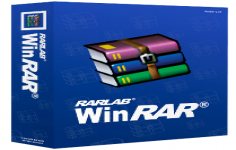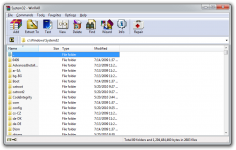 WinRAR 5.60 Beta 1 (32-bit)
WinRAR 5.60 Beta 1 (32-bit)
RARLab - ( Shareware)
The very popular WinRAR compress any file or folder offering the possibility to protect or to recover them in case of necessity.
WinRAR is a reference in the field of archiving data compression utilities. Based on RAR compression algorithm, it can significantly reduce the size of the documents.
WinRAR is very useful when it comes to open its archives in case the user does not have this software because it can create self-extracting archives.
WinRAR integrates with Windows Explorer and allows to compress and decompress files from the context menu. For mainstream users, this feature may be sufficient, but WinRAR also includes more advanced features such as protection of archives by creating recovery volumes possibilities, adding passwords, test archived files or a module for benchmarking test performance by compressing the computer. The encryption uses the AES (Advanced Encryption Standard ) method with a key of 128 bits.
The application is also able to repair a damaged archive when a network transfer was not completed correctly or the storage medium is faulty. But the program is not limited to RAR and ZIP formats because it allows you to view and extract the contents of archives using less common formats such as ACE , 7 -ZIP , CAB , TAR , ISO, GZIP and BZ2 by instance.
- Title:
- WinRAR 5.60 Beta 1 (32-bit)
- File Size:
- 2.8 MB
- Requirements:
- Windows XP / Vista / Windows 7 / Windows 8 / Windows 10 / Windows 10 64-bit
- Language:
- en-us
- License:
- Shareware
- Date Added:
- 11 Mar 2018
- Publisher:
- RARLab
- Homepage:
- http://www.rarsoft.com/
- MD5 Checksum:
- 65661CA9825A8C4360F768562286CF98
Updated WinRAR graphics.
"Repair" command efficiency is improved for recovery record protected RAR5 archives.
"Turn PC off when done" archiving option is changed to "When done" drop down list, so you can turn off, hibernate or sleep your PC after completing archiving.
Use -ioff or -ioff1 command line switch to turn PC off, -ioff2 to hibernate and -ioff3 to sleep your PC after completing an operation.
If encoding of comment file specified in -z<file> switch is not defined with -sc switch, RAR attempts to detect UTF-8, UTF-16LE and UTF-16BE encodings based on the byte order mask and data validity tests.
WinRAR attempts to detect ANSI, OEM and UTF-8 encodings of ZIP archive comments automatically.
"Internal viewer/Use DOS encoding" option in "Settings/Viewer" is replaced with "Internal viewer/Autodetect encoding". If "Autodetect encoding" is enabled, the internal viewer attempts to detect ANSI (Windows), OEM (DOS), UTF-8 and UTF-16 encodings.
Normally Windows Explorer context menu contains only extraction commands if single archive has been right clicked. You can override this by specifying one or more space separated masks in "Always display archiving items for" option in Settings/Integration/Context menu items", so archiving commands are always displayed for these file types even if file was recognized as archive. If you wish both archiving and extraction commands present for all archives, place "*" here.
SFX module "SetupCode" command accepts an optional integer parameter allowing to control mapping of setup program and SFX own error codes. It is also accessible as "Exit code adjustment" option in "Advanced SFX options/Setup" dialog.
New "Show more information" WinRAR command line -im switch.
If a wrong password is entered when unpacking an encrypted file in ZIP archive, WinRAR proposes to enter a valid password for same file again instead of aborting extraction.
If a wrong password is entered when opening or unpacking RAR archive with encrypted file names, WinRAR proposes to enter a valid password again instead of aborting the operation. Previous versions already did so for RAR archives with encrypted file data, but aborted for archives with file name encryption.
WinRAR recognizes GZIP files with arbitrary data preceding an actual GZIP archive, such as .scexe firmware files.
@filelist parameter can be specified in "Files to add" field of archiving dialog. In this case WinRAR will attempt the list of archiving files from 'filelist' file, which should be the plain text, one file name per line.
Info dialog:
Compression ratio graph is updated.
"Names and data" is displayed in "Encryption" field for archives with encrypted file names.
Full archive name is displayed if mouse pointer is placed over an archive name in the operation progress window. It can be useful if archive name is lengthy and does not fit to available window space.
If -ts1 switch is used with -u or -f, file time comparison is performed with 1 second precision. Previosuly in such case we could wrongly treat an adding file as newer than archived just because we compared the high precision adding file time against the low precision archived file time.
"Update" and "Fresh" commands ('u' and 'f' in the command line mode) quit immediately if no files are to be updated. Previously they created a temporary archive before quitting when updating archives with recovery record or quick open information.
Prompt is issued after creating 500 volumes from WinRAR GUI shell, so user can continue or quit further archiving. It is done to prevent creating many thousands of volumes in case of wrongly entered volume size.
WinRAR uses megabytes instead of bytes as default units for volume size field in the archiving dialog.
"Repair" command issues "Recovery record is corrupt" message after repairing RAR5 archive containing a broken recovery record. Previously such message was issued only by "Test" command and "Repair" handled most of recovery record damages silently.
Bugs fixed:
Fixed potential security issues when processing corrupt RAR archives.
Non-English characters in TAR files with PAX extended headers were not displayed correctly.
"rar x arcname.rar .." command unpacked files to current folder instead of its parent.
Pasting files from Windows Explorer to archive opened in WinRAR blocked further copy and paste operations in Explorer until archiving was finished.
SFX module issued "The specified password is incorrect" message infinitely not prompting for correct password once a wrong password was entered.
If "Delete mode: Always" was selected when extracting and user pressed "Cancel" in the file overwrite or password prompt, an archive could be deleted even after cancelling extraction for .zip and .7z formats.
Related software
2.3/5 from 188 users

